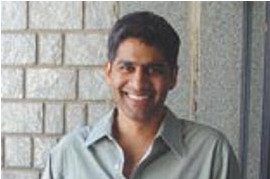Dr. Kaustubh Rau - Research Report 2004-05
Research Report 2004 2005 :
Mechanisms of damage by lasers pulses to single cells a nd tissue
Highly focused pulsed lasers have been widely used in biology to investigate cellular function by ablation of specific organelles in single cells. In biotechnology pulsed lasers have emerged as an attractive method to cause cell lysis (i.e. membrane rupture) for single cell analysis. In both instances, there is limited understanding of basic mechanisms of laser induced damage due to the challenges posed by the small spatial scales and fast time scales over which these processes occur. It is known that focusing nanosecond laser pulses using high numerical aperture microscope objectives leads to cavitation bubble formation. We have used time-resolved imaging on the nanosecond to microsecond time scale to show that cell lysis was caused by the outward fluid flow during the rapid cavitation bubble expansion. Time-resolved imaging also enabled quantitative estimation of mechanical forces incident upon cells during the damage process. This work produced a detailed understanding of cellular response to cavitation bubbles and also provided evidence of the ability of cells to withstand considerable deformation due to fluid shear. In future work we plan to extend the time-resolved imaging technique to examining laser damage in 3-D tissue systems. This has relevance for clinical fields such as ophthalmic surgery and ultrasound mediated drug delivery where cavitation forces are at play in the damage process.
|
Targeted transfection of cells using focused laser pulses. The cell on the left was irradiated with femtosecond laser pulses (12 milliion pulses with pulse energy of 1 nano-joule at 800 nm), to drill an opening in the plasma membrane. The success of the cellular microsurgery is demonstrated by uptake of propidium iodide (red) from the extra-cellular medium into the cell. This cell also exhibits blebbing caused by mechanical forces generated during irradiation. The cell on the right remains undisturbed during this procedure indicating the localized nature of the damage process.
|
As techniques for analyzing single cells continue to prove important in biology and medicine, developing tools for addressing single cells in tissue is viewed as critical for advancing this field. Highly focused pulsed lasers (laser microbeams) offer significant advantages for non-contact manipulation of cells, from microsurgery and transfection to lysis and tissue ablation. Understanding basic mechanisms of cell injury by pulsed lasers will prove critical for their development for applications in single cell analysis.
Laser microbeams can cause injury via several complex processes and their study is challenging due to the small spatial scales and f ast time scales i nvolved. Our goal is to understand these mechanisms using a combination of physical and biological techniques.
In preliminary wo rk using time-resolved techniques we have shown that injury in cell monolayers by laser pulses is primarily caused by outward fluid flow due to cavitation bubble expansion (Figure 1). This work also provided estimates of shear stress necessary to cause cell lysis. At present a laser-microbeam system with time-resolved imaging capabilities is being developed to study cell injury in 3-D engineered tissue constructs. Biological assays will also be used to monitor effects of laser pulses on cells in these samples. A key goal is to correlate the effects of the mechanical forces generated by focused laser pulses to the observed biological response. These studies will thus provide insights on the range of cellular phenomena caused by mechanical shock in an in-vitro tissue system. The imaging platform will be designed to be scalable for general studies of cavitation phenomena in biology.
|
Figure 1. Time-resolved imaging of laser-induced cell lysis and shear stress estimation due to fluid flow. a. Time resolved image acquired at 7.76 µs after laser pulse delivery. The large cavitation bubble that is generated causes cell lysis during bubble expansion. As the bubble slows down it also deforms cells without causing lysis. b. Temporal profile of shear stress due to fluid flow experienced by cells situated 24 µm from the site of laser pulse delivery. These cells experience a maximum shear stress of 160 kPa without being lysed indicating their ability to withstand large forces on nanosecond timescales. |



